
Tumulus of Bougon
Encyclopedia
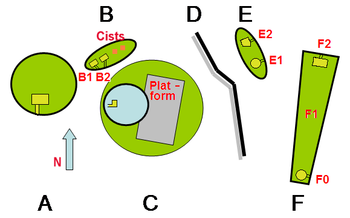
Tumulus
A tumulus is a mound of earth and stones raised over a grave or graves. Tumuli are also known as barrows, burial mounds, Hügelgrab or kurgans, and can be found throughout much of the world. A tumulus composed largely or entirely of stones is usually referred to as a cairn...
of Bougon or Necropolis
Necropolis
A necropolis is a large cemetery or burial ground, usually including structural tombs. The word comes from the Greek νεκρόπολις - nekropolis, literally meaning "city of the dead"...
of Bougon (French
French language
French is a Romance language spoken as a first language in France, the Romandy region in Switzerland, Wallonia and Brussels in Belgium, Monaco, the regions of Quebec and Acadia in Canada, and by various communities elsewhere. Second-language speakers of French are distributed throughout many parts...
: "Tumulus
Tumulus
A tumulus is a mound of earth and stones raised over a grave or graves. Tumuli are also known as barrows, burial mounds, Hügelgrab or kurgans, and can be found throughout much of the world. A tumulus composed largely or entirely of stones is usually referred to as a cairn...
de Bougon", "Nécropole de Bougon") is a group of five Neolithic
Neolithic
The Neolithic Age, Era, or Period, or New Stone Age, was a period in the development of human technology, beginning about 9500 BC in some parts of the Middle East, and later in other parts of the world. It is traditionally considered as the last part of the Stone Age...
monuments (barrows or burial mounds) located in Bougon
Bougon
Bougon is a commune in the Deux-Sèvres department in the Poitou-Charentes region in western France.-References:*...
near La-Mothe-Saint-Héray, between Exoudon and Pamproux
Pamproux
Pamproux is a commune in the Deux-Sèvres département, Poitou-Charentes, France....
in Poitou-Charentes
Poitou-Charentes
Poitou-Charentes is an administrative region in central western France comprising four departments: Charente, Charente-Maritime, Deux-Sèvres and Vienne. The regional capital is Poitiers.-Politics:The regional council is composed of 56 members...
, France
France
The French Republic , The French Republic , The French Republic , (commonly known as France , is a unitary semi-presidential republic in Western Europe with several overseas territories and islands located on other continents and in the Indian, Pacific, and Atlantic oceans. Metropolitan France...
. Their discovery in 1840 raised great scientific interest. To protect the monuments, the site was acquired by the department of Deux-Sèvres
Deux-Sèvres
Deux-Sèvres is a French département. Deux-Sèvres literally means "two Sèvres": the Sèvre Nantaise and the Sèvre Niortaise are two rivers which have their sources in the department.-History:...
in 1873. Excavations resumed in the late 1960s. The oldest structures of this prehistoric
Prehistory
Prehistory is the span of time before recorded history. Prehistory can refer to the period of human existence before the availability of those written records with which recorded history begins. More broadly, it refers to all the time preceding human existence and the invention of writing...
monument date to 4800 BC.
The archaeological site
The site is located on a limestone plateau within a loop of the river Bougon. The area used to be known as "Les Chirons".Tumulus A
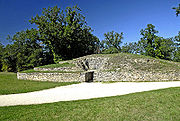

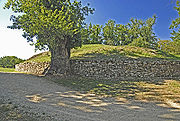
During its excavation in 1840, about 200 skeleton
Skeleton
The skeleton is the body part that forms the supporting structure of an organism. There are two different skeletal types: the exoskeleton, which is the stable outer shell of an organism, and the endoskeleton, which forms the support structure inside the body.In a figurative sense, skeleton can...
s were discovered in three layers, separated by stone slabs. The vague reports of that early excavation prevent any detailed chronological analysis. Accompanying finds included flat-bottomed and round-bottomed pottery
Pottery
Pottery is the material from which the potteryware is made, of which major types include earthenware, stoneware and porcelain. The place where such wares are made is also called a pottery . Pottery also refers to the art or craft of the potter or the manufacture of pottery...
, beads, pierced teeth, chains of seashells and stone tools, including a diorite
Diorite
Diorite is a grey to dark grey intermediate intrusive igneous rock composed principally of plagioclase feldspar , biotite, hornblende, and/or pyroxene. It may contain small amounts of quartz, microcline and olivine. Zircon, apatite, sphene, magnetite, ilmenite and sulfides occur as accessory...
mace. More recent excavations showed that the grave was abandoned shortly after its construction. The passage had been blocked with a large stone slab. At its base lay the skull of a man who had undergone three trepanation
Trepanation
Trepanning, also known as trephination, trephining or making a burr hole, is a surgical intervention in which a hole is drilled or scraped into the human skull, exposing the dura mater in order to treat health problems related to intracranial diseases. It may also refer to any "burr" hole created...
s during his lifetime. Pottery was also found in front of the monument's facade
Facade
A facade or façade is generally one exterior side of a building, usually, but not always, the front. The word comes from the French language, literally meaning "frontage" or "face"....
, suggesting that cult
Cult
The word cult in current popular usage usually refers to a group whose beliefs or practices are considered abnormal or bizarre. The word originally denoted a system of ritual practices...
activities, entailing the deposition of pottery, took place after its closure.
About 1,000 years later, the monument was re-used for more burial
Burial
Burial is the act of placing a person or object into the ground. This is accomplished by excavating a pit or trench, placing an object in it, and covering it over.-History:...
s by people of a different culture who reached the passage from above.
Tumulus B
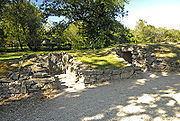
Cist
A cist from ) is a small stone-built coffin-like box or ossuary used to hold the bodies of the dead. Examples can be found across Europe and in the Middle East....
s, with no access passage. The mound's west part has two larger rectangular chambers, each accessible via a passage from the south.
Chamber B1
The chamber B1 is a small square structure, built from monolithic slabs. Such constructions are known as dolmen angoumoisin. A 2.2 m long passage leads to a chamber of 2 by 1.5 m, built simply from four wall slabs. One of them has a hook carved out of its side. A fifth slab covers the chamber. Little archaeological material was found in it, probably because it had been cleared and reused in the 3rd millennium BC.Chamber B2
Excavation here revealed a distinctive treatment of human remains. About ten skullcaps were found placed upside down in two rows. They were associated with several longbones.Cists
The cists in the east part of the mound were discovered in 1978. Set in the centre of the mound, they were built of small stones. Both were empty, but they may possibly be associated with a large heap of Late Neolithic pottery sherdSherd
In archaeology, a sherd is commonly a historic or prehistoric fragment of pottery, although the term is occasionally used to refer to fragments of stone and glass vessels as well....
s found nearby.
Tumulus C

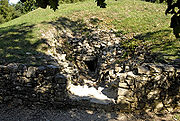
- a rectangular platform and
- a smaller circular mound.
Earlier mound
The earlier mound had a diameter of 24 m and a height of 4 m. It contained a small off-centre chamber (2 by 1.45 m), accessible by a passage from the west. Six slabs formed its floor. It contained four skeletons (including an old woman), as well as pottery and flintFlint
Flint is a hard, sedimentary cryptocrystalline form of the mineral quartz, categorized as a variety of chert. It occurs chiefly as nodules and masses in sedimentary rocks, such as chalks and limestones. Inside the nodule, flint is usually dark grey, black, green, white, or brown in colour, and...
tools.
Platform
Attached to the east side of the earlier mound was a large platform, 20 m x 40 m in size. In front of each of the three sides of its tall facade wall, a double burial of an adult and a child was found.Structure D
A 35m long and 2 m tall drystone wall subdivides the Bougon complex in two zones, separating Tumuli E and F from the rest of the site. Several finds, including a piece of wood, proved the Neolithic date of this feature, unparalleled among the megalithic monuments of France.Tumulus E
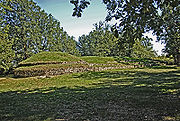
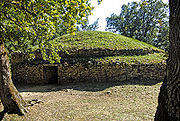
Chamber E1
The southern chamber has a diameter of 3m and has a circular, tholosTholos
Τholos is the name given to several Ancient Greek structures and buildings:**The Tholos at Athens was the building which housed the Prytaneion, or seat of government, in ancient Athens...
-like structure. Its foundation level is built with 11 blocks, set in a foundation trench. The construction is reminiscent of the chamber of a tumulus in Bazoges-en-Pareds (Vendée
Vendée
The Vendée is a department in the Pays-de-la-Loire region in west central France, on the Atlantic Ocean. The name Vendée is taken from the Vendée river which runs through the south-eastern part of the department.-History:...
).
Excavation revealed five or six skeletons, accompanied by pottery, bone tools and stone tools, dated to between 4,000 and 3500 BC, making it one of the most ancient dolmen structures in Central France.
Chamber E2
E2, in the northern part of E, is near-square, with one apse-like side. It is suggested that it was altered around 2500 BC, long after it was erected. Materials from the chamber included arrowheads, knives and scrapers. Coarse round-bottomed pottery was also present.Tumulus F
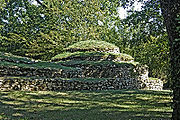

F0
This monument was built in the first half of the 5th millennium BC and reused in the 3rd millennium BC. It is one of the oldest examples of monumental architecture in Atlantic France. Excavation in 1977 revealed a steep hemispherical mound containing a circular structure of 2.5 m in diameter. It lies within a triple concentric drystone facade and is covered with a corbelled vault. The architecture is similar to the complex of Er-Mané near CarnacCarnac
Carnac is a commune beside the Gulf of Morbihan on the south coast of Brittany in the Morbihan department in north-western France.Its inhabitants are called Carnacois...
, Brittany
Brittany
Brittany is a cultural and administrative region in the north-west of France. Previously a kingdom and then a duchy, Brittany was united to the Kingdom of France in 1532 as a province. Brittany has also been referred to as Less, Lesser or Little Britain...
.
The tomb, which dates from about 4700 BC, contained the unarticulated remains of about ten individuals, half of them children. A layer of red clay had been placed atop the natural floor level. There were few artifacts, mainly two pots, six bone chisels and some flint tools. They lay near the bones on two stones of around 30 cm height that protruded from the wall. The latter use was also associated with that structure.
F1
The area known as F1 contains no burial chamber. It consists of a series of structures, some of them rectangular, that served to stabilise the monument. The walls separating them reach the ground level the tomb was built upon. The earth of the mound contained the remains of a man, a woman and a child.F2
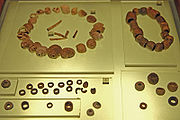
The scarce finds from the chamber included pottery fragments, some unusual jewellery (beads) and flint tools.
Synopsis
The 1,000-year development of architecture at Bougon can be subdivided in three phases:- round or oval mounds with corbel-vaulted chambers
- elongated mounds with small rectangular megalithic chambers
- large rectangular megalithic chambers
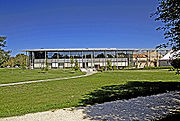
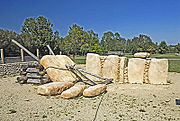
Museum
The Bougon museum, opened in 1993, is a modern structure, incorporating an ancient farmhouse. The exhibition is focused on prehistory in general and the Neolithic in particular. It includes the excavated material from the site, but also replicas of a room in the Neolithic settlement of CatalhoyukÇatalhöyük
Çatalhöyük was a very large Neolithic and Chalcolithic settlement in southern Anatolia, which existed from approximately 7500 BCE to 5700 BCE...
(Turkey
Turkey
Turkey , known officially as the Republic of Turkey , is a Eurasian country located in Western Asia and in East Thrace in Southeastern Europe...
) and of the passage tomb art from Gavrinis
Gavrinis
Gavrinis is a small island, situated in the Gulf of Morbihan in Brittany, France. It contains the Gavrinis tomb, a megalithic monument notable for its abundance of megalithic art in the European Neolithic. Administratively, it is part of the commune of Larmor-Baden.-Geography:Reachable by boat...
(Brittany
Brittany
Brittany is a cultural and administrative region in the north-west of France. Previously a kingdom and then a duchy, Brittany was united to the Kingdom of France in 1532 as a province. Brittany has also been referred to as Less, Lesser or Little Britain...
). The museum also has an outside area with displays of experimental archaeology
Experimental archaeology
Experimental archaeology employs a number of different methods, techniques, analyses, and approaches in order to generate and test hypotheses, based upon archaeological source material, like ancient structures or artifacts. It should not be confused with primitive technology which is not concerned...
, including reconstructions concerned with prehistoric methods for the transport and construction of megalithic monuments.

